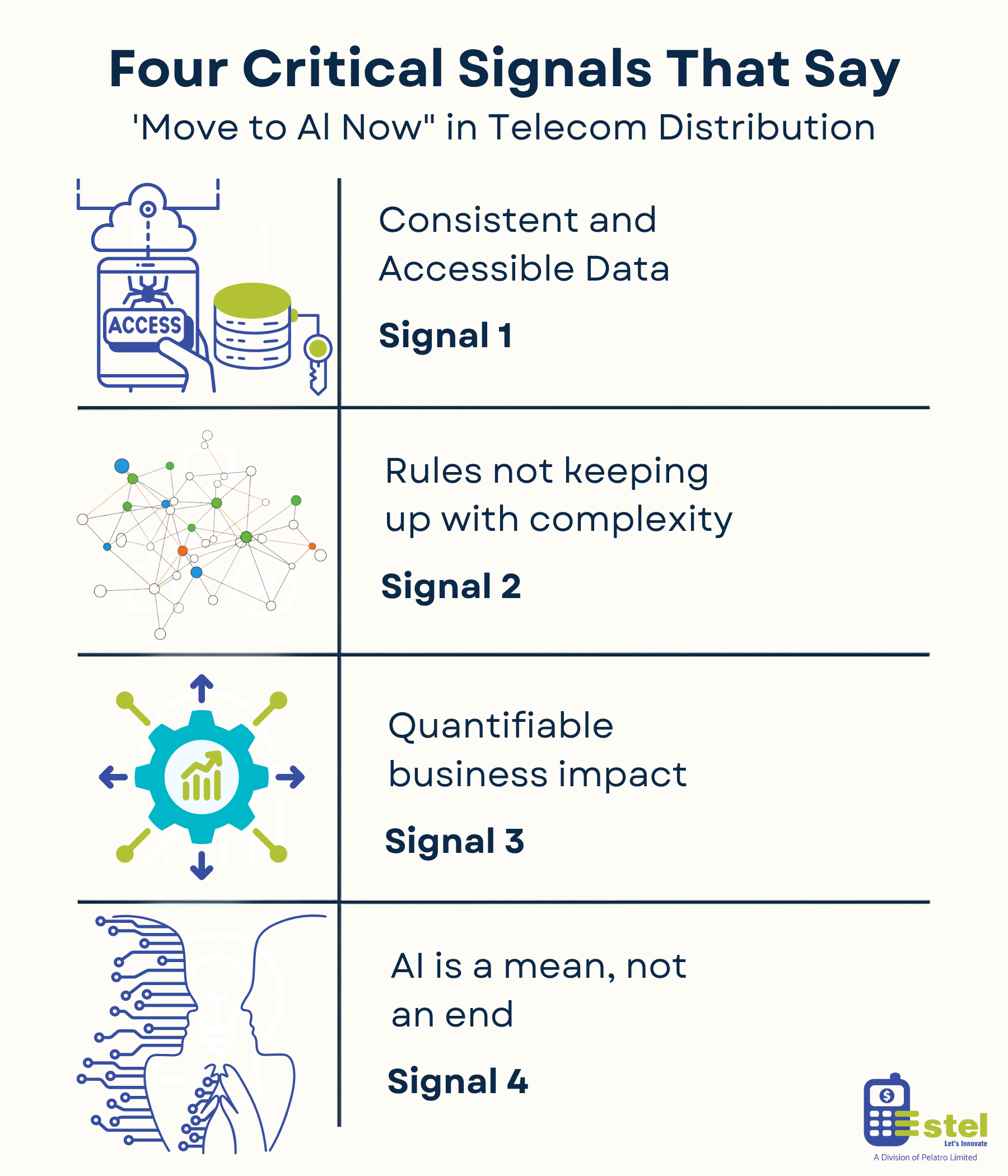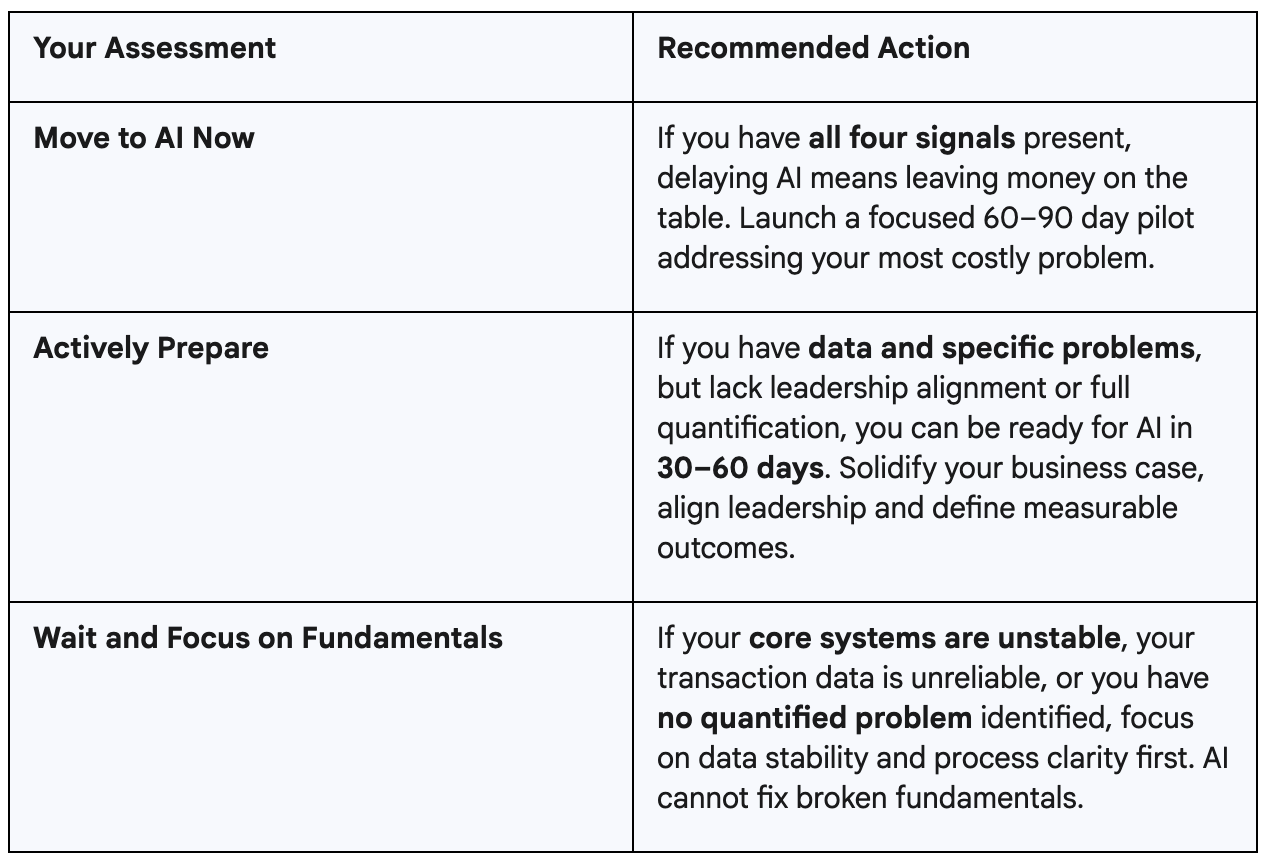The question isn't whether AI will transform telecom sales and distribution—it's whether you're implementing it at the right moment for maximum impact. For CSOs, CIOs, and heads of S&D managing complex retail networks, timing your AI investment can mean the difference between competitive advantage and costly missteps.
Too many telecom operators approach AI as either an urgent imperative or a distant luxury. The reality is that AI delivers transformative value when applied to the right problems at the right time for an organization.
This guide helps you identify the optimal timing through four critical readiness signals.
Understanding the AI Opportunity in Telecom Distribution and Sales
Before discussing timing, it's essential to understand what AI can realistically achieve in your telecom sales and distribution operations. AI excels at pattern recognition across large datasets—exactly what telecom distribution generates through millions of daily transactions across dealer networks, recharge platforms, and inventory systems.
The most impactful AI applications don't replace human judgment. Instead, they uncover insights that would be impossible to detect manually, enabling your teams to make faster, more informed decisions.
Example: A sales supervisor may oversee 1,000 retailers. AI can continuously monitor all 1,000, flagging those that show early churn signals to field agents, while the supervisor focuses on strategic relationships and targeted interventions.
This augmentation approach—combining AI's pattern recognition with human expertise—consistently delivers faster ROI and higher adoption than full-automation attempts.
The Core Question: Solve Problems, Not Chase Technology
Before diving into readiness, remember this fundamental principle: AI should solve specific business problems, not serve as a strategy in itself.
The wrong question: "Should we implement AI in our distribution operations?"
The right question: "What's costing us the most money or preventing the most growth, and is AI the best way to solve it?"
This reframing changes everything. You evaluate AI as one potential solution to measurable business challenges. Sometimes the answer is AI; sometimes it's simply better processes or clearer accountability.
Four Critical Signals That Say "Move to AI Now" in Telecom Distribution
Infographic about the 4 signals

Signal 1: Your Transaction Data Is Consistent and Accessible
Move to AI when: Your core systems generate regular, structured transaction data. You don't need perfect data quality or complete integration; just reliable data capture from your key revenue-generating activities.
Reality Check: Through your recharge platform, you already have substantial data assets. Every transaction—what retailers sell, when they sell it, how frequently they reorder—creates predictive signals. Even if your inventory management or dealer systems aren't fully integrated, your recharge data alone provides a foundation for AI applications.
Practical threshold: If you can export transaction-level data for your entire retail network for the past quarter without manual intervention, you're ready.
Why this matters: AI models learn from patterns in data and improve with data volume and consistency. Starting with what you have—even if it's primarily recharge transaction data—allows you to demonstrate value quickly. You can expand data sources as your AI capabilities mature and ROI becomes visible.
Signal 2: Your Rule-Based Systems Are Hitting Their Limits
Move to AI when: Your current automation handles routine tasks adequately, but you're facing diminishing returns. Perhaps your inventory reordering rules work for standard scenarios but fail during promotional periods, or your retailer segmentation is accurate but never adapts to behavioral shifts.
Key indicators you've hit the ceiling:
- Field force management: Your system assigns sales reps to visit retailers on fixed schedules (weekly, bi-weekly, monthly) based on retailer size or revenue tier. But this misses critical dynamics—a high-performing retailer whose sales velocity is declining by 15% month-over-month doesn't trigger a visit because they're still above threshold. Meanwhile, a mid-tier retailer showing 40% growth in high-margin products gets standard attention because the rules don't recognize opportunity.
- Inventory allocation: You use reorder point rules (when stock hits X units, order Y units) that work for 70% of products but fail for the other 30%. Static reorder rules fail to anticipate promotions or seasonal spikes.
- Retailer performance tracking: Your dashboard flags retailers as "at-risk" when transaction volume drops 25% versus the prior month. But by the time this threshold triggers, the retailer is often already lost. Early warning signs—subtle shifts in product mix, gradual decline in visit frequency, increasing payment delays—go unnoticed because your rules only watch volume.
Why this happens: Rule-based systems work well for straightforward scenarios but struggle with multi-variable patterns. Real retailer behavior involves dozens of signals interacting simultaneously. AI excels at detecting these complex patterns without requiring you to write explicit rules for every scenario.
The opportunity: When rules become a maintenance burden, it's time for AI-based automation.
Signal 3: You Can Quantify the Business Impact
Move to AI when: You can articulate specific, measurable business outcomes with clear financial impact:
- Dealer retention: Predict at-risk retailers 30-60 days in advance. If your dealer churn rate is 15% annually and you manage 50,000 dealers, reducing churn by just 3 percentage points retains 1,500 dealers and their associated lifetime revenue.
- Inventory optimization: Forecast recharge demand by product, region, and timeframe to reduce stock-outs. A 20% reduction in stock-outs directly translates to recovered revenue, while a 15% reduction in excess inventory frees capital.
- Dealer performance optimization: Identify patterns in your top-performing dealers and detect similar opportunities among lower performers. If you can help 10% of lower-performing dealers increase sales by 25%, the revenue impact is immediately quantifiable.
- Sales team effectiveness: Prioritize which retailers need attention, which products to promote, and when to intervene based on the likelihood of success rather than arbitrary schedules.
The clarity test: Write down your expected ROI in revenue protected, costs reduced, or efficiency gained—with reasonable assumptions.
"Reducing retailer churn from 15% to 12% across our network protects $4.2M in annual revenue"
Why this matters: AI initiatives require sustained budget and organizational adjustment. Without a clear, quantified business case, projects inevitably lose momentum. The validation process should include your finance, sales, and operations leaders.
💡 Ready to quantify your AI opportunity? Let’s identify your top business impact areas in just one session. [Book your assessment →]
Signal 4: Leadership Understands AI as a Means, Not an End
Move to AI when: Your executive team approaches AI as a tool to solve a specific business problem, not a checkbox for innovation.
What readiness looks like:
- The conversation starts with operational challenges: "We are losing $20M in stock-outs yearly. Can we forecast demand better?"
- Success is measured by impact, not sophistication.
- Leaders ask “How will this improve performance?”, not "Which AI model will we use?"
Why this matters: AI projects without executive clarity inevitably drift toward technology demonstrations rather than delivering business outcomes.
Making the Decision: Your Strategic Assessment
Based on the four critical signals, here is a consolidated view of your next strategic step:

The Bottom Line: When to Move
For telecom operators, the right time to move to AI is earlier than expected, but only when focused on real problems.
You need:
- Consistent transaction data (even if imperfect).
- A specific, quantified business problem.
- Leadership that views AI as a solution, not a strategy.
- Willingness to start small and expand based on proven value.
Operators who act pragmatically—not reactively—gain a lasting competitive edge.
Your Next Step: Quantifying the Opportunity with Estel
Are you confident you have a business problem that AI can solve, but you're struggling to quantify its financial impact?
This is where many high-potential AI projects stall. Before launching a pilot, you need to validate your assumptions and calculate a defensible ROI.
Estel help telecom operators move from ideas to validated business cases. With our diagnostic tools, we help you identify the right signals and build clear, data-backed business models that gain executive support.
Move from "We think we can save money" to "We will protect $4.2M in annual revenue by reducing churn."
Contact us today to schedule a brief assessment and turn your operational challenges into a validated AI business case. (Add a link to our Contact page)
Other articles that may interest you:
The AI Readiness Scale: Where Does Your Sales & Distribution Organization Stand?
About Estel:
Estel empowers telecom operators to modernize their sales and distribution through AI-enabled platforms covering recharge, mobile money, and inventory management.





